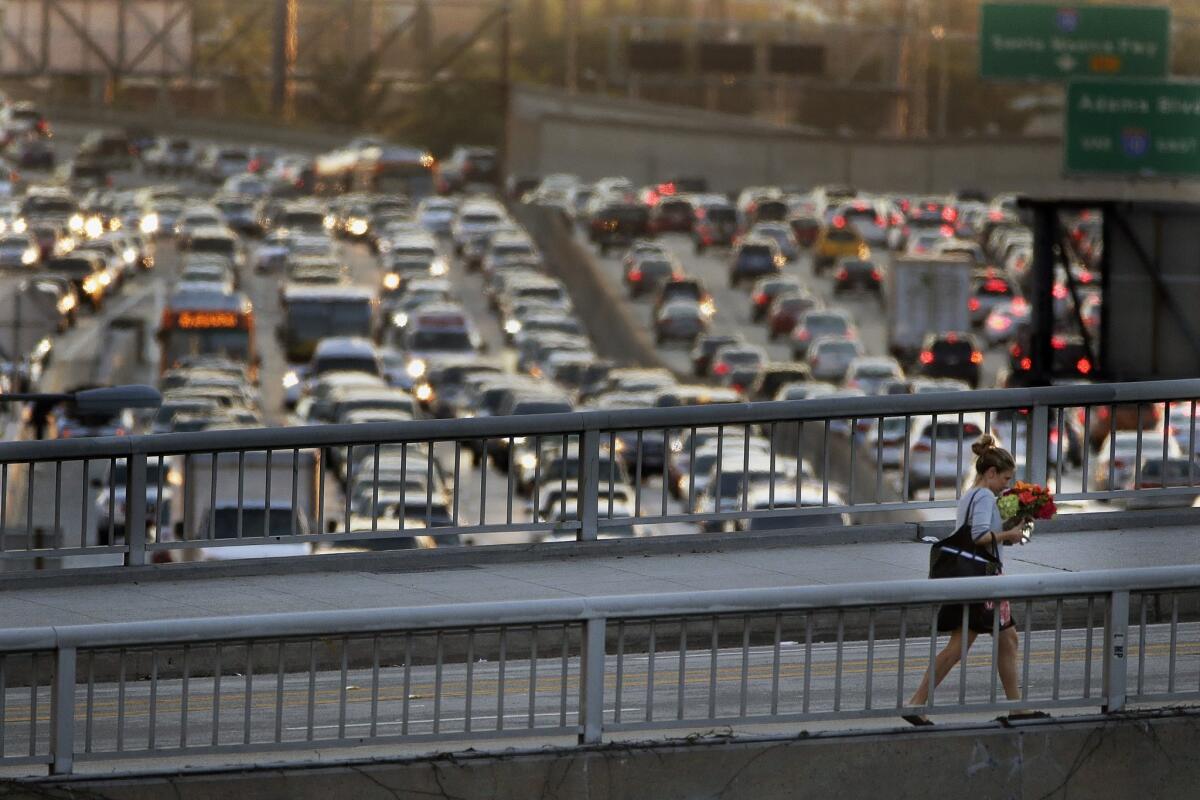California Commute: As economy improves, L.A. and O.C. rise in traffic congestion rankings

Several years ago, it looked as if the Los Angeles-Orange county area had finally shaken its reputation as the king of congestion.
Studies showed that Chicago and Washington, D.C., had eclipsed this region as the nation’s leader in sluggish commutes.
Now, as the economy recovers from the Great Recession, L.A. and the O.C. are making a slow comeback in the congestion rankings.
Average annual delays for motorists and the length of daily commutes are on the increase again, according to census data and the Texas Transportation Institute at Texas A&M University. Only Washington, D.C., surpasses the Los Angeles-Orange County area in terms of congestion-related delays.
The institute’s 2012 mobility study shows that motorists in the two counties experience on average 61 hours of delay annually, a four-hour increase over 2008, the early part of the economic downturn. That’s far above the national average of 38 hours.
Washington, D.C.-area motorists average 67 hours of delay a year, while Chicago has tumbled to seventh place in the ranking, at 51 hours.
A Times analysis of the U.S. Census Bureau’s American Community Survey reveals a similar trend but also suggests that commuting times have increased more on the Los Angeles side of the county line.
From 2009 to 2013, the average time to get to work grew more than two minutes in L.A. County to 27.73 minutes. In Orange County, the commute increased less than half that to 23.80 minutes.
The steepest rise in the larger Southern California area occurred in Riverside County, where the commute time jumped more than four minutes to 27.76 minutes.
Over the longer term, from 1990 to 2010, census data show that commute times for all modes of travel trended upward about 10% in L.A. County to 26 minutes but dipped very slightly in the O.C., to 23.21 minutes.
Various factors, including the lingering effects of the recession as well as changes in lifestyles and travel habits, affect travel delays and commute times.
“The best solution to congestion is, unfortunately, unemployment,” said Alan E. Pisarski, a transportation policy consultant and author of the “Commuting in America” book series.
During the recession, unemployment ranged from 8% to 13% in Los Angeles and surrounding counties. Today, it runs from 5.8% in Orange County to slightly more than 8% in Los Angeles, Riverside and San Bernardino counties. A large number of discouraged workers have stopped looking for jobs.
Pisarski said that during the economic downturn, consumer spending on transportation dropped significantly and has been recovering very slowly. Truck travel, a major contributor to congestion, also is down, he added.
“The growth in delay and commute times is really quite modest,” said Martin Wachs, a transportation expert in UCLA’s urban planning department. “Given the lack of investment in highways and the economic recovery, I would have expected more of an increase.”
The good news, in the long view: Annual congestion-related delay for Greater Los Angeles is still below the peak of 79 hours per motorist reached in 2006, when gas prices were low and the economy was booming. The rise in average commute times is only a few minutes more than in 1990.
Wachs said it’s likely people are adjusting their work and travel habits to avoid commuting during rush hour. They work at home, change hours, move closer to their jobs and otherwise try to travel during off-peak periods.
Brian Taylor, an urban planning professor at UCLA, agreed with Wachs and Pisarski but cautioned that rising commute times may involve factors beyond street and highway congestion.
For example, longer travel distances and greater use of bicycles and public transit can increase trip times. Such a shift might be underway in the Los Angeles area, where the portion of those driving to work has dipped by as many as three percentage points since 1990.
Whether congestion-related delays and commute times will keep increasing isn’t clear. “It’s hard to tell if this is a permanent trend,” Pisarski said. “Congestion is immensely variable around the country.”
But if the economy continues to recover, Taylor said congestion will probably worsen.
Follow @LADeadline16 for transportation news.
More to Read
Sign up for Essential California
The most important California stories and recommendations in your inbox every morning.
You may occasionally receive promotional content from the Los Angeles Times.











